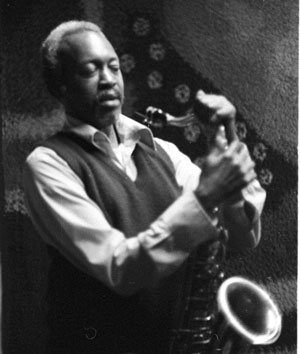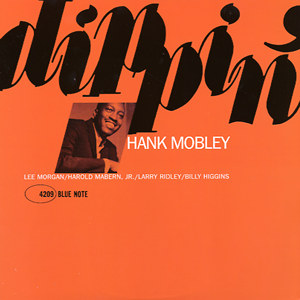Ballin' – Hank Mobley
For this snappy 3/4 swinger, the changes are a clever adaptation of the standard Lover. A transcription of Hank Mobley’s solo is available.
- Recording: Hank Mobley - Dippin'
- Recorded on: June 18, 1965
- Label: Blue Note (BLP 4209)
- Concert Key: E-flat
- Vocal Range: , to
- Style: 3/4 swing (medium up)
- Trumpet - Lee Morgan
- Tenor Sax - Hank Mobley
- Piano - Harold Mabern
- Bass - Larry Ridley
- Drums - Billy Higgins
Video
- Description
- Historical Notes
- Solos
- Piano Corner
- Bass Corner
- Drum Corner
- Guitar Corner
- Inside & Beyond
- Minus You
As shown by this song, Hank Mobley’s snappy rhythmic feel works just as well in 3/4 as in 4/4. The melody of Ballin’ is quite simple and catchy, with plenty of open space for the rhythm section; there is no melody on the bridge. Our Condensed Score, which is also the rhythm section part, includes the top notes of the piano voicings everywhere the horns are not playing. Both the melody and rhythm section feel are based on a dotted quarter-note pulse throughout. On the recording, drummer Billy Higgins is playing 2-against-3 swing which feels like alternating dotted eighth notes and 16th notes in 2/4 (with the measure length the same); this is shown at the beginning of the Condensed Score.
The changes of this 64-measure AABC song are ultimately based on the standard Lover, but with many alterations—particularly tritone substitutions which transform the A section from descending half steps to a circle of fourths. The original chromatic descent is still obvious in the melody. The bridge goes to G major and B♭ major as in the bridge of Lover, but this time with the chords rising in half steps from these respective key centers. The last note of the A and C section melody is an A; at A1 and C this is harmonized with A7 for a stepwise “walk down” back to E♭ for the next section. The same note in A2 is over an E♭ major chord.
There is an eight-measure rhythm section intro, with changes that resolve from E♭ to B and back—a “Tadd Dameron” turnaround. The ending on the recording is a rhythm section vamp and fade on the last four measures. We have added an ending with a final melody phrase, shown in our lead sheets and 2nd parts. On the condensed score, there are two optional codas: vamp and fade like the recording, again showing the top notes of the piano, or vamp until the last phrase of the melody.
The horns harmonize in tritones (augmented fourths) in the third and fourth measures and again in the seventh and eighth measures; our added final coda phrase is also harmonized.
A transcription of Hank Mobley’s solo is available; click on Solos for more details.
The changes of this 64-measure AABC song are ultimately based on the standard Lover, but with many alterations—particularly tritone substitutions which transform the A section from descending half steps to a circle of fourths. The original chromatic descent is still obvious in the melody. The bridge goes to G major and B♭ major as in the bridge of Lover, but this time with the chords rising in half steps from these respective key centers. The last note of the A and C section melody is an A; at A1 and C this is harmonized with A7 for a stepwise “walk down” back to E♭ for the next section. The same note in A2 is over an E♭ major chord.
There is an eight-measure rhythm section intro, with changes that resolve from E♭ to B and back—a “Tadd Dameron” turnaround. The ending on the recording is a rhythm section vamp and fade on the last four measures. We have added an ending with a final melody phrase, shown in our lead sheets and 2nd parts. On the condensed score, there are two optional codas: vamp and fade like the recording, again showing the top notes of the piano, or vamp until the last phrase of the melody.
The horns harmonize in tritones (augmented fourths) in the third and fourth measures and again in the seventh and eighth measures; our added final coda phrase is also harmonized.
A transcription of Hank Mobley’s solo is available; click on Solos for more details.
Lover, the Richard Rodgers/Lorenz Hart song whose chord structure is used in Ballin’, was originally written in 3/4. However, as a jazz standard Lover became better known in 4/4, especially through recordings by Charlie Parker and by Sonny Clark.
Hank Mobley only recorded four original compositions in 3/4, on four consecutive sessions of which “Dippin’" was the second. For the last of these, check out Cute ’n Pretty, from “A Slice Of The Top”. On both this song and Ballin’ check out how tightly locked in Hank is with trumpeter Lee Morgan; it’s possible he wrote these songs with Lee’s rhythmic feel in mind, especially since Lee wrote and recorded many songs in 3/4.
Hank Mobley only recorded four original compositions in 3/4, on four consecutive sessions of which “Dippin’" was the second. For the last of these, check out Cute ’n Pretty, from “A Slice Of The Top”. On both this song and Ballin’ check out how tightly locked in Hank is with trumpeter Lee Morgan; it’s possible he wrote these songs with Lee’s rhythmic feel in mind, especially since Lee wrote and recorded many songs in 3/4.
CLIP Hank Mobley plays the last solo on this track, as he does on quite a few recordings. His solo is two choruses long. This is a lyrical solo, though not without that signature Mobley snap at times. All of his lines outline the changes very clearly, whether in smoother bebop vocabulary or more angular shapes.
Related Songs
Email Send Ballin' to a friend
Send this page to a friend via email. Add your name or email in the first field. In the second, add one or more email addresses, separated by a comma.

Hank Mobley
July 7, 1930 – May 30, 1986
Hank Mobley is one of the most acclaimed tenor saxophonists in modern jazz history. He is recognized by musicians and critics alike as one of the most important and eloquent jazz instrumentalists of all time. He recorded well over 100 of his own original compositions and left an indelible mark on the post-bop jazz scene. Read more...
There was a problem.
...

